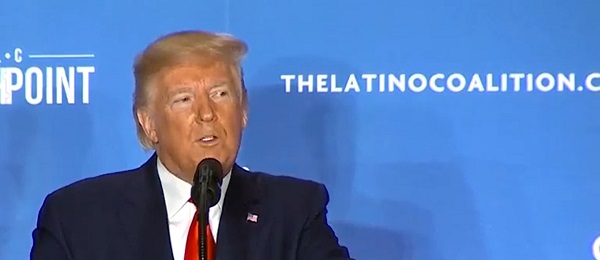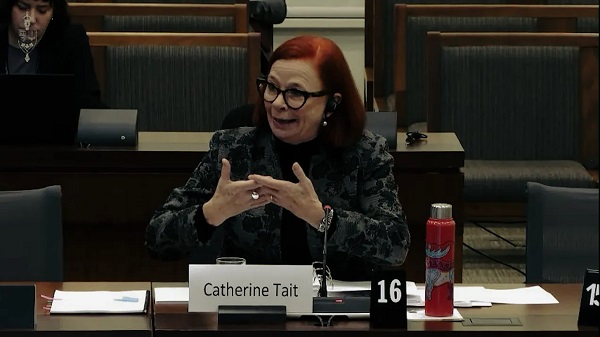illegal immigration
Exclusive Interview: Panama Border Security Chief Says Many U.S.-Bound Terror Suspects Caught in Darien Gap Region

SENAFRONT Director General Jorge Gabea at his headquarters office in Panama City, August 2024. Photo by Todd Bensman.
From the Center for Immigration Studies
By Todd Bensman
The bad news: The migrant flood prompted by Biden-Harris policies means only a tiny fraction can be checked
PANAMA CITY, Panama — In April 2022, the American public finally heard the sound of national security alarms about the U.S. southern border, when U.S. Customs and Border Protection began publishing, on a monthly basis, the numbers of FBI watch-listed terrorists caught illegally crossing (a record-breaking 378 from FY2021 through July 2024).
But what most Americans do not know is that many more terrorism suspects en route to the U.S. border could be added to that alarming number, except these ones were caught in Panama coming out of the notorious Darien Gap jungle, pulled off the migrant trails, and never accounted for in CBP’s public data reports.
New official information about these additional terrorism suspects interrupted on their way to the American border comes by way of an exclusive Center for Immigration Studies interview with the chief of Panama’s National Border Service (SENAFRONT), Director General Jorge Gabea, at agency headquarters just off the Panama Canal.
Asked to comment about SENAFRONT’s reported August arrest of three Afghan terror suspects whose biometrics were taken and checked at a Darien Province immigrant reception station (described in the SENAFRONT tweet below), Gabea responded that the report was “not fake”.
Se detecta a través de acciones de perfilamiento y pruebas biométricas a tres terroristas afganos y a tres colombianos con antecedentes criminales en la Estación Temporal de Recepción Migratoria de Lajas Blancas en Darién.#CentinelasDeLaPatria pic.twitter.com/xvnaMyBjOX
— SENAFRONT PANAMÁ (@senafrontpanama) August 3, 2024
Three Afghan terrorists and three Colombians with criminal records are detected through profiling actions and biometric tests at the Lajas Blancas Temporary Immigration Reception Station in Darién. #CentinelasDeLaPatria
“We did take and profile a few members of a terrorist cell from … Afghanistan,” he said. “We linked and we profiled them to be members of an active cell. They were members of a Salafist group, and they had links with different activities.”
But then Gabea added that this was far from a one-off.
“We have many stories of that. We don’t just have one. We have many stories of that, from Somalia, from Yemen … from Syria, from Africa.”
Gabea would not put a number on the “many stories”.
But for all those good-news stories of short-circuited U.S. border-crossings by known terrorist suspects, he also suggested that the record-breaking flood hundreds of thousands of migrants a year from 150-plus nations that began pouring through the Darien Gap from Colombia in 2021 has severely hampered the very counterterrorism screening programs that catch them and get them off the trails early.
”3 Percent in This Moment” — The Broken Counterterrorism Dam. I knew exactly what Gabea was talking about. Following a previous trip to Panama in 2018, I produced reporting about those counterterrorism programs. This was several years before the historic mass migration event that the Biden-Harris administration would unleash starting in 2021. (See 2019 video below.)
Since 2011, SENAFRONT has worked closely with in-country FBI and DHS agents on counterterrorism programs that use U.S.-provided equipment to collect migrant biometrics like fingerprints and photos and run them through terrorism databases looking for positive hits before the foreign nationals move on north.
But SENAFRONT’s director general indicated that so many began coming through the gap during the historic mass migration to the U.S. border that Central American authorities are scarcely able to screen even a fraction of them.
“Maybe at this moment … we can check like 3 percent and, in the worst moment, 1 percent,” Gabea told me. “We don’t have the capability to screen everybody.”
So many are coming that agents on the ground are left to “profile” immigrants for priority collection and checks, probably meaning if they are young men from Muslim-majority nations. But eyeballing always eludes perfection.
”Throughout the Years, We Were Catching a Lot … Hundreds.” This profound reduction in coverage to 1 percent or 3 percent in Panama stands in contrast with a 90-percent rate of screening immigrants in the country when the program started in 2011, when flows were usually well under 10,000 per year.
This is according to Edward Dolan, a former Homeland Security Investigations agent who worked deeply with these programs while later serving as DHS’s Regional Attache for Central America in the U.S. embassy in Panama City. Dolan retired from service in 2019 but still lives and works in Panama, where I met with him in a coffee shop.
“Throughout the years, we were catching a lot” of watch-listed terrorists, Dolan told me. “From like 2015 to 2019, it was hundreds.”
But checking the 550,000 immigrants that crossed in just 2023 and almost 250,000 so far in 2024?
“That’s insurmountable,” Dolan said. “I can’t imagine trying to manage what they have now.”
Dolan said those low screening rates in Panama help explain the record-high number of terror suspects getting caught and counted illegally crossing the U.S. border.
“All you have to do is look at what’s being reported at the southwest border and then go back and look at the numbers in 2019 [zero] and 2020 [three],” Dolan said. “That tells the story itself.”
Delayed Counterterrorism Responses from Colombia to Texas. So many are coming in through the Darien Gap, Gabea confirmed, that “active terrorist” migrants are sometimes mistakenly freed to proceed to countries north before biometric information submitted in Panama produces a positive hit.
A red flag goes out then, of course, and with a little luck, “they take them from the migrant flow”, Gabea explained, for interviews with American and local agents, the eventual deportation to “their official port of entry. Maybe it’s in Africa. Maybe it’s Bosnia. We return them to their previous position.”
Clearly, however, many are too long gone and don’t get caught until they hit the American border, if ever. On August 5, the U.S. House Judiciary Committee issued an interim report revealing that since January 2021, CPB released into the United States “at least” 99 border-crossing immigrants who were on the FBI’s terrorist watchlist database.
The entire multinational counterterrorism net now stands reduced in capability, and the bad guys know it, Dolan said.
“If you’re a terrorist,” he said. “this is how you’re going to come to the United States.”
The Center for Immigration Studies is an independent, non-partisan, non-profit research organization founded in 1985. It is the nation’s only think tank devoted exclusively to research and policy analysis of the economic, social, demographic, fiscal, and other impacts of immigration on the United States.
illegal immigration
Court rules in favor of Texas in razor wire case

From The Center Square
By
Attorney General Ken Paxton also said the ruling was a “huge win for Texas…. We sued immediately when the federal government was observed destroying fences to let illegal aliens enter, and we’ve fought every step of the way for Texas sovereignty and security.”
A panel of three judges on the Fifth U.S. Circuit Court of Appeals ruled in favor of Texas in a lawsuit filed over its concertina wire barriers.
The court ruled 2-1 in a case that may set the tone for two other cases before the court related to Texas’ border security operations.
Circuit Judge Stuart Kyle Duncan wrote for the majority, with Judge Don Willett joining him. Judge Irma Carrillo Ramirez dissented, arguing Texas did not meet “its burden to show a waiver of sovereign immunity or a likelihood of success on the merits.”
The ruling was issued 13 months after Texas sued the Biden administration after it destroyed concertina wire barriers it erected on state land.
The court was asked to decide whether Border Patrol agents can legally cut concertina wire fencing erected by Texas law enforcement along its border with Mexico. The Biden administration ordered Gov. Greg Abbott to remove it, arguing he was interfering with federal immigration operations. Abbott refused, arguing that the administration was facilitating illegal entry and violating federal law. In response, the administration ordered Border Patrol agents to use a bulldozer and remove wire fencing. Abbott sued, arguing they were destroying Texas property and Texas has the legal authority to erect barriers on state land.
Texas requested the district court to issue an injunction to block Border Patrol agents from removing the fencing, which it denied despite agreeing with Texas’ arguments.
The court “agreed with Texas on the facts: not only was Border Patrol unhampered by the wire, but its agents had breached the wire numerous times ‘for no apparent purpose other than to allow migrants easier entrance further inland,’” the Fifth Circuit’s 75-page ruling states. However, it denied Texas’ request arguing the federal government had sovereign immunity.
Texas next appealed to the Fifth Circuit, which granted the injunction pending appeal. The Biden administration appealed to the U.S. Supreme Court, which vacated the injunction without any stated reason.
The Supreme Court’s ruling didn’t deter Texas, which continued building and erecting concertina wire in the Eagle Pass area, and later established the military base for Texas’ border security mission, Operation Lone Star, there. OLS officers also expanded concertina wire barriers in other key areas along its border.
“The Texas National Guard continues to hold the line in Eagle Pass,” Abbott said at the time. “Texas will not back down from our efforts to secure the border in Biden’s absence.”
The three-judge panel ruled that Texas “is entitled to a preliminary injunction.” The ruling states that the Biden administration “clearly waived sovereign immunity as to Texas’s state law claims under § 702 of the Administrative Procedure Act,” which it says “is supported by a flood of uncontradicted circuit precedent to which the United States has no answer.”
The Fifth Circuit also rejected other Biden administration arguments, including that Texas was erecting barriers to safeguard its own property, not to “regulate Border Patrol.”
The ruling reversed the district court’s judgment and granted Texas’ preliminary injunction. The court also prohibited the federal government from “damaging, destroying, or otherwise interfering with Texas’s c-wire fence in the vicinity of Eagle Pass,” including Shelby Park, which Abbott shut down after learning that the Biden administration was using it as a staging ground to facilitate illegal entry into the US.
Abbott lauded the Fifth Circuit ruling, saying, “The federal court of appeals just ruled that Texas has the right to build the razor wire border wall that we have constructed to deny illegal entry into our state and that Biden was wrong to cut our razor wire. We continue adding more razor wire border barrier.”
Attorney General Ken Paxton also said the ruling was a “huge win for Texas.”
“The Biden Administration has been enjoined from damaging, destroying, or otherwise interfering with Texas’s border fencing. We sued immediately when the federal government was observed destroying fences to let illegal aliens enter, and we’ve fought every step of the way for Texas sovereignty and security.”
With weeks left in the administration, the concertina wire barrier case is unlikely to be appealed for a full court review.
In May, the court is scheduled to hear arguments on a lawsuit related to Texas’ marine barriers in the Rio Grande River, unless the case is dropped by the incoming Trump administration. Another case before the court is over Texas’ border security law, SB 4.
Business
Canada Scrambles To Secure Border After Trump Threatens Massive Tariff


From the Daily Caller News Foundation
By Jason Hopkins
The Canadian government made clear its beefing up its border security apparatus after President-elect Donald Trump threatened to impose sweeping tariffs against Canada and Mexico if the flow of illegal immigration and drugs are not reined in.
Trump in November announced on social media that he would impose a 25% tariff on all products from Canada and Mexico unless both countries do more to limit the level of illicit drugs and illegal immigration entering into the United States. In response, Canada Prime Minister Justin Trudeau met with the president-elect at his residence in Mar-a-Largo and his government has detailed what more it’s doing to bolster immigration enforcement.
“We got, I think, a mutual understanding of what they’re concerned about in terms of border security,” Minister of Public Safety Dominic LeBlanc, who accompanied Trudeau at Mar-a-Largo, said of the meeting in an interview with Canadian media. “All of their concerns are shared by Canadians and by the government of Canada.”
“We talked about the security posture currently at the border that we believe to be effective, and we also discussed additional measures and visible measures that we’re going to put in place over the coming weeks,” LeBlanc continued. “And we also established, Rosemary, a personal series of rapport that I think will continue to allow us to make that case.”
Trudeau’s Liberal Party-led government has pivoted on border enforcement since its first days in power.
The Royal Canadian Mounted Police (RCMP) — the country’s law enforcement arm that patrols the border — is preparing to beef up its immigration enforcement capabilities by hiring more staff, adding more vehicles and creating more processing facilities, in the chance that there is an immigration surge sparked by Trump’s presidential election victory. The moves are a change in direction from Trudeau’s public declaration in January 2017 that Canada was a “welcoming” country and that “diversity is our strength” just days after Trump was sworn into office the first time.
While encounters along the U.S.-Canada border remain a fraction of what’s experienced at the southern border, activity has risen in recent months. Border Patrol agents made nearly 24,000 apprehensions along the northern border in fiscal year 2024 — marking a roughly 140% rise in apprehensions made the previous fiscal year, according to the latest data from Customs and Border Protection.
“While a change to U.S. border policy could result in an increase in migrants traveling north toward the Canada-U.S. border and between ports of entry, the RCMP now has valuable tools and insights to address this movement that were not previously in place,” read an RCMP statement provided to the Daily Caller News Foundation. “New mechanisms have been established which enable the RCMP to effectively manage apprehensions of irregular migrants between the ports.”
Trudeau’s pivot on illegal immigration enforcement follows the Canadian population growing more hawkish on the issue, public opinion surveys have indicated. Other polls also indicate Trudeau’s Liberal Party will face a beating at the voting booth in October 2025 against the Conservative Party, led by Member of Parliament Pierre Poilievre.
Trudeau’s recent overtures largely differ from Mexican President Claudia Sheinbaum, who has indicated she is not willing to bend the knee to Trump’s tariff threats. The Mexican leader in November said “there will be a response in kind” to any tariff levied on Mexican goods going into the U.S., and she appeared to deny the president-elect’s claims that she agreed to do more to beef up border security in a recent phone call.
Trump, who has vowed to embark on an incredibly hawkish immigration agenda once he re-enters office, has tapped a number of hardliners to lead his efforts. The president-elect announced South Dakota Gov. Kristi Noem to lead the Department of Homeland Security, former acting Immigration and Customs Enforcement Director Tom Homan to serve as border czar and longtime aide Stephen Miller to serve as deputy chief of staff for policy.
-

 Alberta2 days ago
Alberta2 days agoThe Alberta energy transition you haven’t heard about
-

 espionage2 days ago
espionage2 days agoShock interview reveals big names connected to international paedophile network
-

 Brownstone Institute2 days ago
Brownstone Institute2 days agoJustice Is Served: Jay Bhattacharya Chosen to Be NIH Director
-

 Business2 days ago
Business2 days agoGreen Energy or Green Grift? SDTC at the Center of a $38 Million Scandal
-

 Alberta2 days ago
Alberta2 days agoA Trump Effort To Revive Keystone XL Would Likely Be Purely Symbolic
-

 Crime2 days ago
Crime2 days agoThe Bureau Exclusive: The US Government Fentanyl Case Against China, Canada, Mexico
-

 Daily Caller2 days ago
Daily Caller2 days agoCelebrities Do Not Have The Political Star Power They Thought They Did
-

 David Clinton23 hours ago
David Clinton23 hours agoWhat Happens When Ministries Go Rogue?






